The tendency towards disorder as a driving force in chemical reactions
A drop of red dye slowly diffuses through a beaker of water, demonstrating the driving force to increase the disorder of a system as it approaches equilibrium.

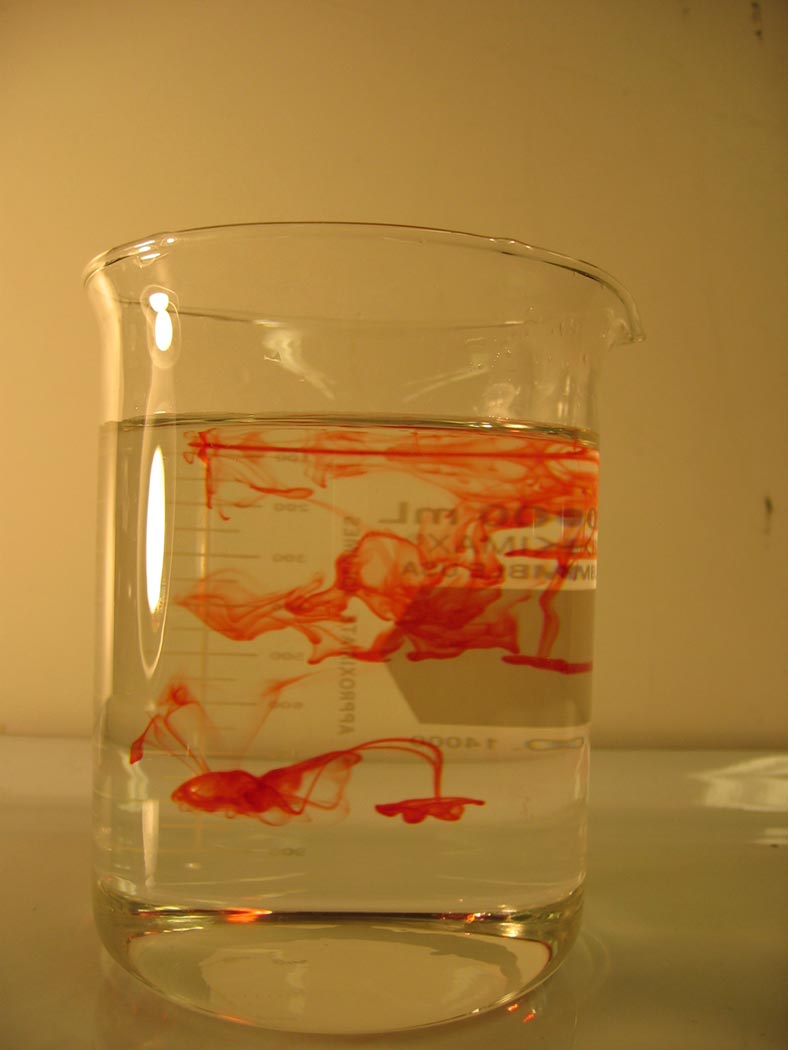
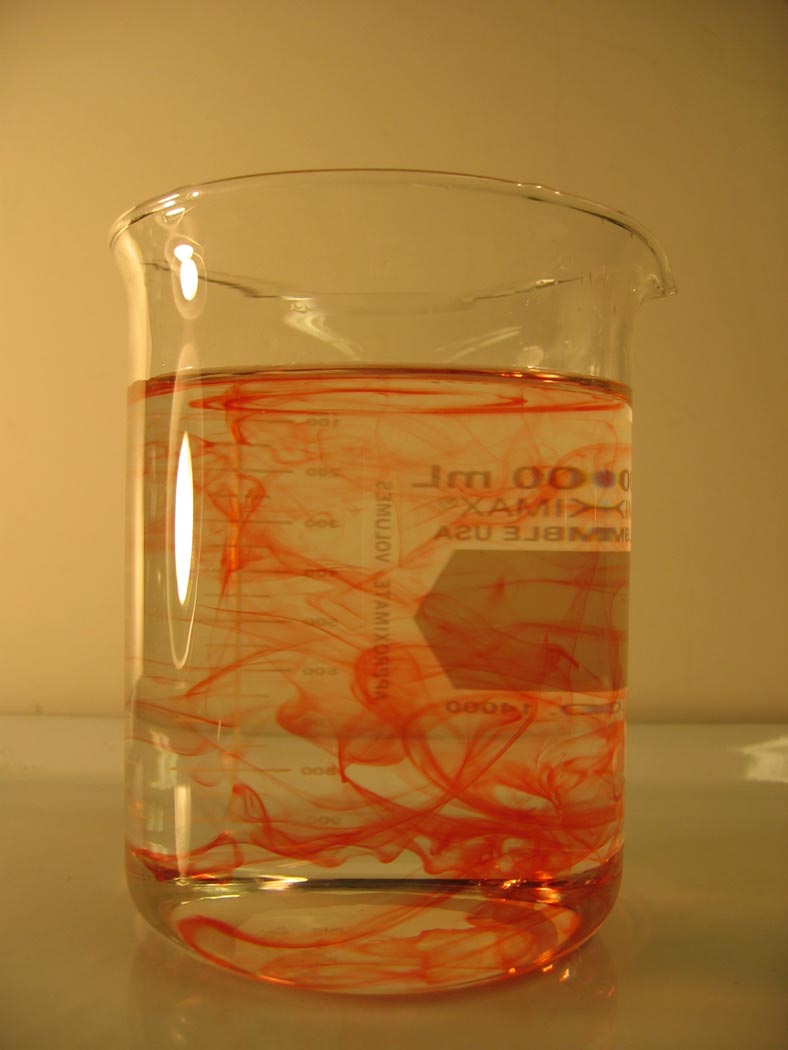
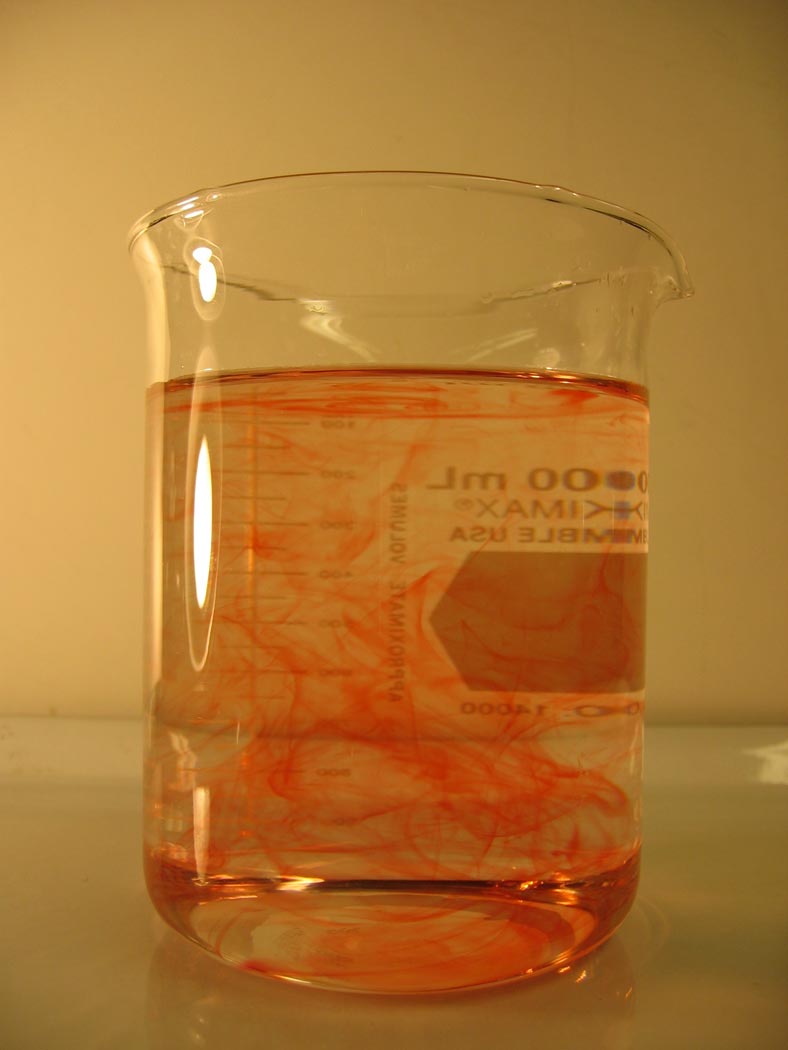
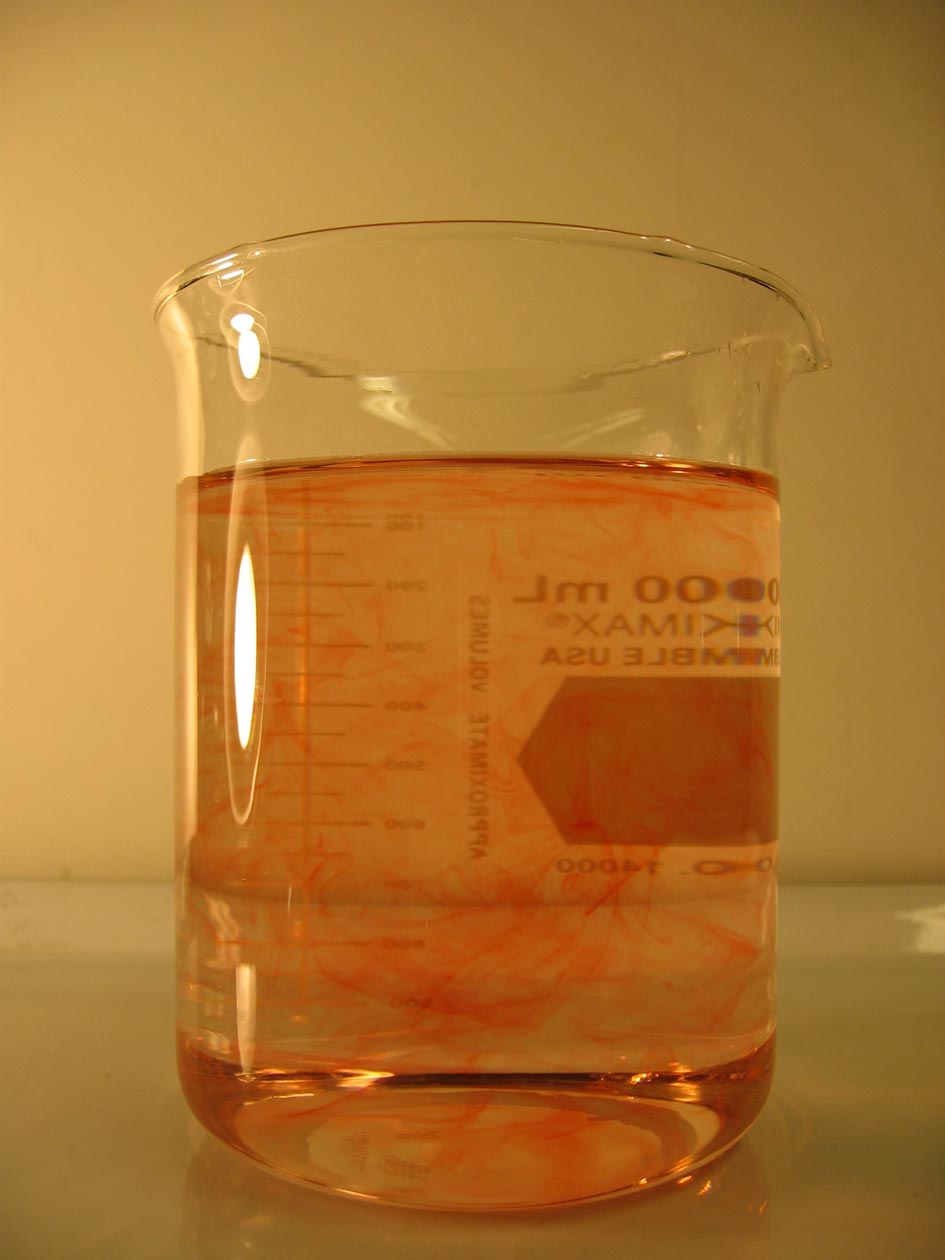
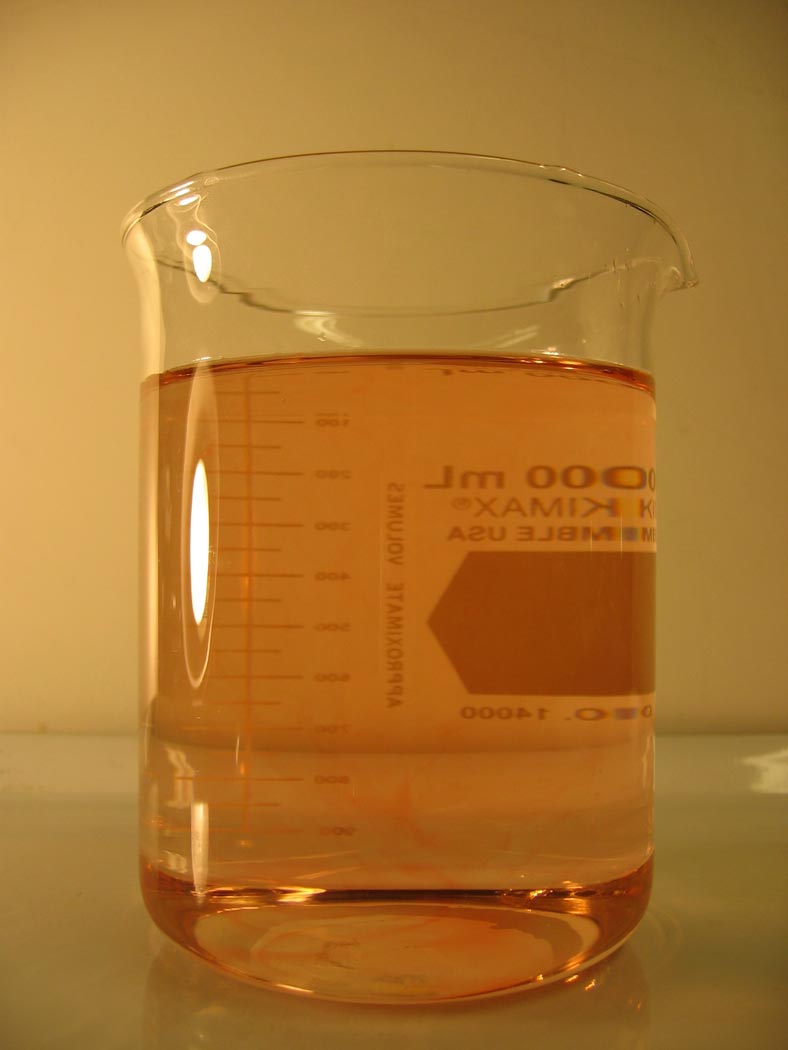 Ingredients: large beaker, food coloring
Ingredients: large beaker, food coloring
Procedure: A complete recipe follows.
1. Place a drop of food coloring in a beaker of "still" water.
2. Observe the spread of the colorful food dye.
Understanding: The mixing of dye in water is something we have all observed. Considering the process at the atomic level, we understand that the chaotic thermal motion of the atoms and molecules leads to the process of diffusion and mixing. As the temperature of the water is increased, the average speed of the water molecules increases, and the rate of diffusion increases as well.
This mixing process moves towards a state of equilibrium that we observe to be a uniform distribution of the dye molecules in the beaker. We do not expect that the dye molecules, undergoing chaotic motion, would reorganize themselves into a concentrated droplet. We never observe that to happen. It is not forbidden, however, as the energy for the dye molecules to be found in the drop or dispersed through the solution is essentially the same.
The reason that we observe the mixing of the dye to create a uniform distribution is that there are many ways for the dye molecules to be randomly arranged in a way that they are more or less uniformly distributed in the beaker. However, there are relatively few ways that the molecules can be arranged so that all the dye molecules are in a small, concentrated droplet surrounded by clear, dye-less water.
Ingredients: ammonium chloride, potassium hydroxide
Procedure: A complete recipe follows.
1. A substantial quantity of ammonia gas is made by the reaction of ammonium chloride and potassium hydroxide.
2. The container holding the ammonia gas is opened and the gas is allowed to expand into the surrounding room.
3. The smell of ammonia reaches throughout the room indicating that the ammonia mixes with the air.
Understanding:
As in the mixing of the dye in water, the spreading of the ammonia gas throughout the room is a process that moves forward to a state of equilibrium that consists of a uniform distribution of ammonia in the room. That occurs in spite of the fact that there is no driving force to lower the energy of the system (the ammonia gas and air). The driving force to increase the entropy of the system accounts for the reaction.
The ammonia gas is initially contained in the space of the bottle. Let's suppose that we divide the bottle into cells of some volume that is about the size of an ammonia molecule. That way, there is either one molecule of ammonia in the cell, or no molecule of ammonia in the cell.
Suppose that the volume of the container is Vjar and the volume of the room is Vroom. If the volume of the cell is Vcell then there will be
Ωjar = Vjar/Vcell
Ωroom = Vroom/Vcell
For example, suppose that the jar had a volume of 0.500L. We might take the volume of the cell to be 25 Å3. We know that 0.500L = 500 cm3 and that 25 Å3 = 25 x 10-24 cm3. Then the total number of cells that could be occupied by an ammonia molecule in the half-liter jar would be
Ωjar = 500 cm3 / 25 x 10-24 cm3 = 20 x 1024
If we have one ammonia molecule, there would be Ωjar ways of arranging it in the jar. Suppose we have two ammonia molecules in the jar. There would be Ωjar ways to place the first ammonia molecule, and Ωjar-1 ways to place the second ammonia molecule. There is one cell occupied by the first ammonia molecule, leaving one less cell that the second ammonia molecule might occupy.
So the number of ways of arranging the two ammonia molecules is
Ωjar (Ωjar-1)
If we extend this thinking to N ammonia molecules, we can see that the number of ways of arranging the N ammonia molecules in the jar will be
ΩjarN
ΩroomN
ΩroomN >>
ΩjarN
Entropy is a thermodynamic function that is a measure of the disorder in the system
What we would really like to have is a thermodynamic function that captures the drive to increase the disorder in a system, in the same way that the energy and enthalpy capture the drive to decrease the energy in a system. We want the function to (1) be extensive, like the energy, and (2) be related to the number of states or arrangements of molecules that is possible for the system, our quantitative measure of the disorder in the system.
Let's define a function, S, called the entropy. It is a function of the number of states of the system. It is also extensive and should satisfy the equation
S[Ω2N] = S[ΩN] + S[ΩN]
There are only two functions that can satisfy this demand. One is the "zero function" defined
S[Ω] = 0
S[Ω] = constant ln[Ω]
S[Ω] = kB ln[Ω]
S[Ω2N] = kB ln[Ω2N] = 2NkB ln[Ω] = NkB ln[Ω] + NkB ln[Ω] = S[ΩN] + S[ΩN]
We have a measure of the increase in the number of states for the ammonia in the jar, and the ammonia in the room. What is the change in entropy when the ammonia leaves the jar and expands into the room? The answer is simply
Δ S = kB ln[ΩroomN] - kB ln[ΩjarN] = NkB ln[Ωroom/Ωjar]
Δ S = R ln[Ωroom/Ωjar]
= R ln[Vroom/Vjar]
Consider a crystal of solid carbon monoxide. The carbon monoxide molecule is quite symmetric. There is a very small dipole moment, 0.11D, and the carbon and oxygen ends have a similar electronic structure that is apparent in the triple bonded Lewis electron dot structure. In a crystal of carbon monoxide, it turns out that there is a very small difference between the energy of the crystal if we have all of the carbon monoxide molecules oriented in the same way, or if we have one of the carbon monoxide molecules "flipped" backwards.
Compute the molar entropy of a crystal of carbon monoxide near the absolute zero of temperature. Assume that each carbon monoxide molecule can assume either a forward or backwards orientation in the crystal, and that each orientation is of equal energy. Express your answer in units of J/K.
You can check your answers here.
Ammonia gas in "observed" to spontaneously diffuse out of a container to become uniformly distributed in the lecture hall; it is never observed to completely leave the room to renter the container.
The entropy of disorder in low temperature crystals
Question:
We can use the Boltzmann entropy formula to address a curious and fundamentally important problem related to the entropy of crystals at low temperature.